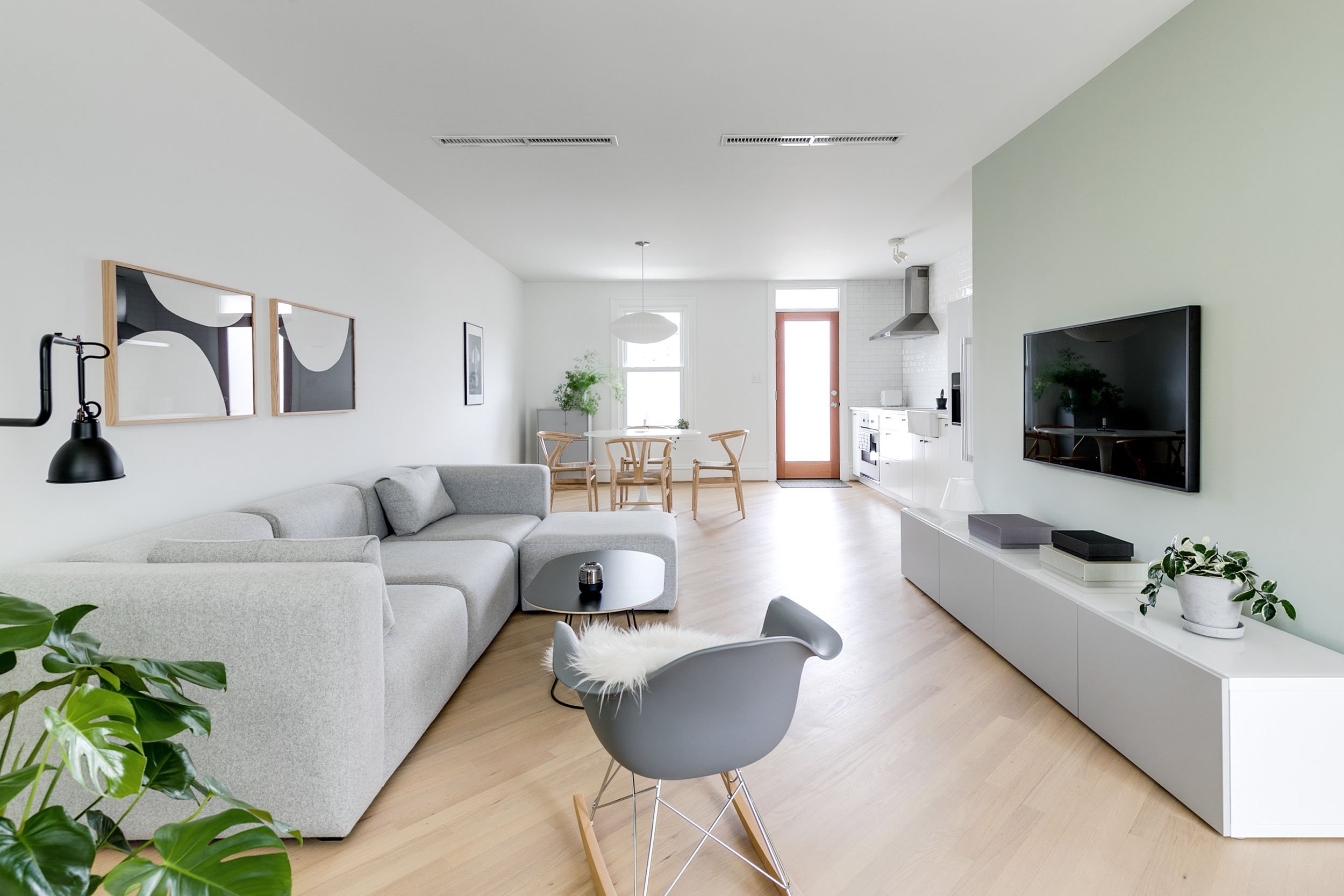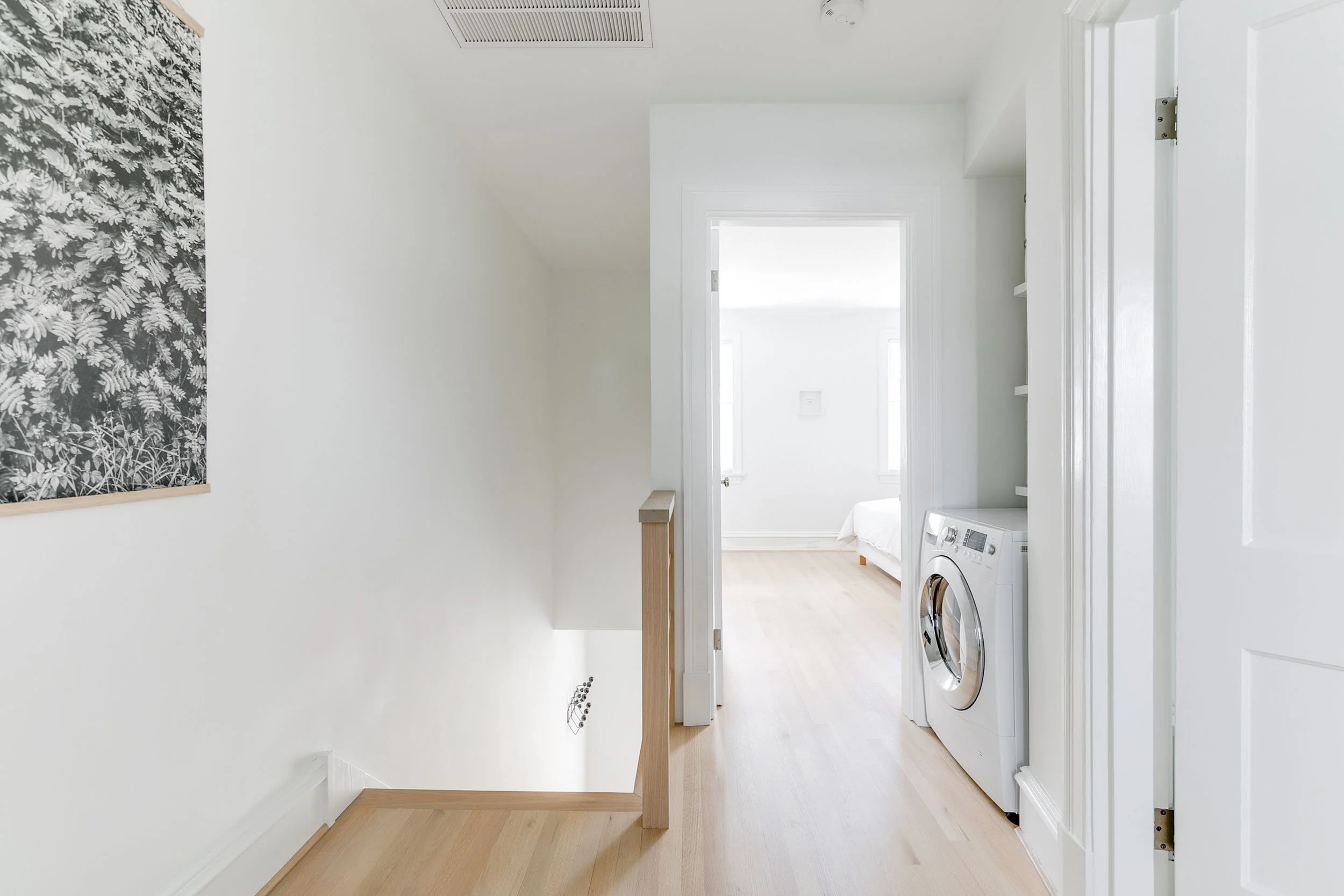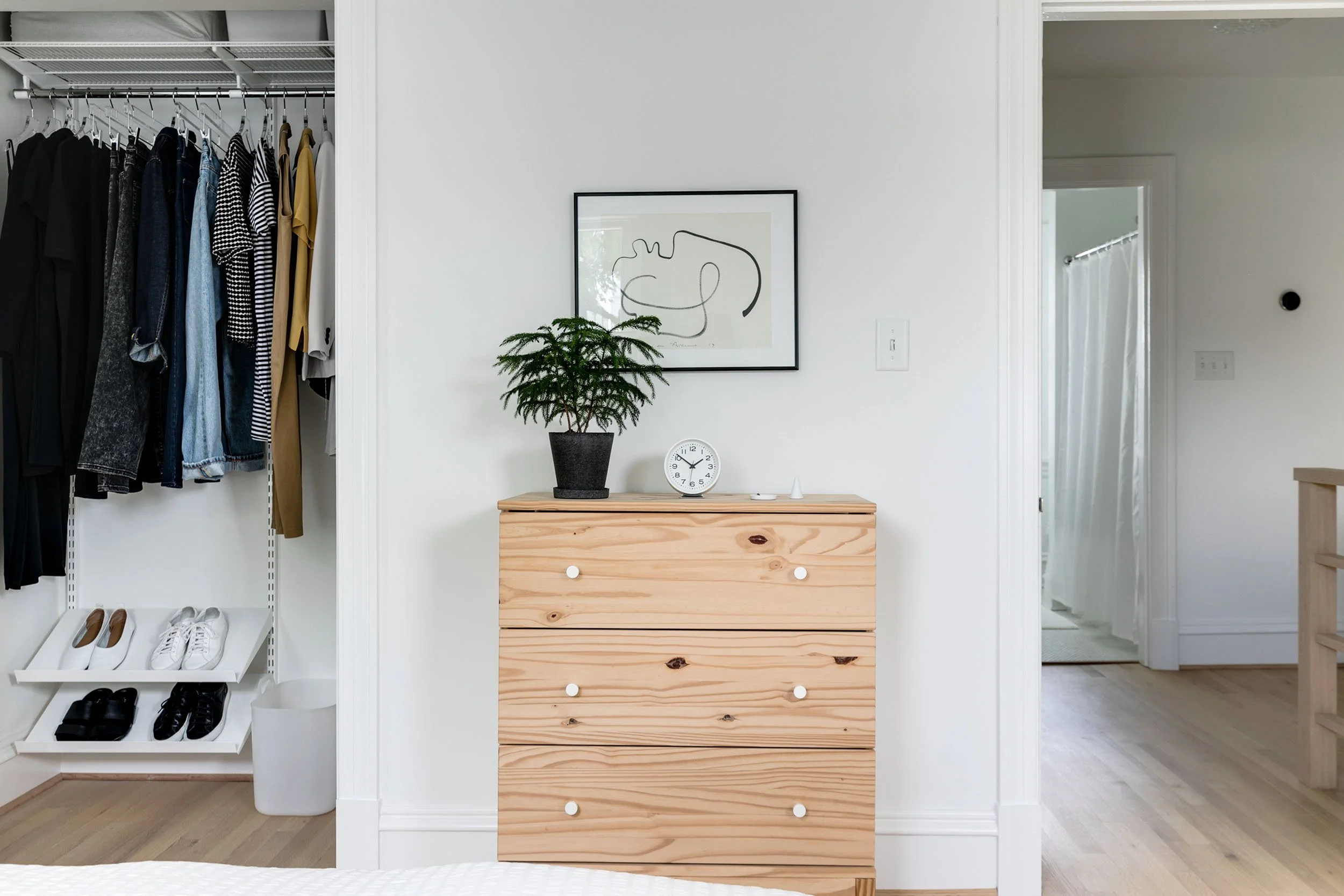How to Create Warm Minimalism in Your Home
Minimalism often gets a bad reputation or is put into a specific aesthetic box; all black and white, harsh lines, cold surfaces, etc. I view minimalism as a holistic approach to life—not an aesthetic—which can be applied at every scale. I’m going to share images of my own home in this post, but minimalism can actually take on an infinite number of aesthetics! I apply minimalist principles to my home design, but also to the way I schedule my days, my hair and skin routine, and even the way I organize my digital files and email. Minimalism is about creating simple, elegant solutions that maximize time, beauty, and function, and therefore minimize stress.
“Minimalism is not about what you own, it’s about why you own it.” — Brian Gardner
My row home in the Fan. All photos credit Mindie Ballard.
“It takes a lot of hard work to make something simple, to truly understand the underlying challenges and come up with elegant solutions. […] It involves digging through the depth of complexity. To be truly simple, you have to go really deep.” — Steve Jobs
I have owned my current Fan row home for just over nine years, and it took me about seven of those years and countless hours of experimentation and tweaking to get it to feel “just right”. If I’m being honest, there are still small details I’m tweaking. As Steve Jobs said, simple isn’t easy, so I’m going to share a bit of what I have learned about creating a space that feels both warm and inviting, but also simple and minimal—what I call warm minimalism.
Start with the core elements
Everything in a home doesn’t need to be completed right away. In fact, I have found it’s better to live in a space for awhile and let it tell you what it needs; to gradually design it over time. There are certain realizations you can only have after spending time in a space for awhile—the way the light changes throughout the seasons, the way your use of the space may change throughout the weeks and months, specific details you may not have initially noticed. By starting with the core elements such as a sofa, a dining table and chairs, a bed, you can allow yourself the flexibility to develop a relationship with the space over time. This approach can feel uncomfortable at times especially if patience isn’t your thing, but it yields a more authentic design in the end. It also provides the opportunity to build a budget for quality pieces, rather than buying everything at once. Quality over quantity, always.
Take an organic approach to the process
Some of the best design moments in my home were “happy accidents”. When we have a fixed vision for what something should look like, the end design can often feel contrived. On the flip side, whenever I allow myself to play, I make some amazing discoveries that have propelled the design process forward. For example, switching the dining and living spaces, or completely rearranging the lamps. At one point, I even broke up my modular sofa into multiple pieces just to see how it would look! Usually I don’t stick with any of these dramatic changes, but by allowing myself to view the space in new way, I discover smaller changes I can make to bring more balance and excitement to the design. It is okay to do things incorrectly and make mistakes—in fact, I believe it’s essential to developing good design.
Minimize clutter & SUBTRACT
This one seems obvious, but it has to be said. There’s no way to appreciate a beautiful home design if your belongings don’t have a place to live. Most people don’t opt for as minimal a home as mine (minimalism and design is part of my life’s work after all), but being intentional about the things we own makes a huge impact on the feel of a home. For additional guidance on this subject, reference my other Minima Journal post, “Beyond Sparking Joy: How to Decide What to Keep or Discard”. I also did a Creative Mornings talk about how each belonging is an opportunity to spark joy in our daily lives: “Living Intentional Moments Through Minimalism”.
“One can furnish a room very luxuriously by taking out furniture rather than putting it in.” — Francis Jourdain
My design process is subtractive. I think human nature is to add more to a space if something feels off—more pillows, more artwork, more tchotchkes. I have found the opposite works best. If something feels wrong, I will remove one or two things at a time, then step back and assess the changes. My roommate in college called this “surveying”, which still makes me chuckle to this day. She would always notice me tweak something in our dorm room, then step back to view it from various angles and assess whether it was an improvement. The Japanese have a term called “ma”, which values the negative space between things as much if not more than the objects themselves. Rather than saying “This space is too cluttered.”, one might say “This space doesn’t have enough ma.” To learn more, check out “MA — The Japanese Concept of Space and Time”.
An organized nook just outside of my bedroom stores laundry supplies, first aid, back stock toiletries, and off-season clothing.
Keep your standards high to limit purchases
There are so many options in the home furnishings market these days, so it helps to have a list of “non-negotiables”—standards you measure potential purchases against. If you fill a space with a lot of pieces you feel “whatever” about, it’s never going to feel warm or minimal. One of my non-negotiables is to never purchase furniture from places like Wayfair or Amazon, or any kind of knock off-designs (some of you may disagree with me here, but that’s okay!). In my experience, these items are cheap quality, don’t last, and are actually overpriced for what you’re getting. As an ex-architect, I have a deep appreciation for the time it takes to develop a quality design with good details. Even IKEA has actual designers behind each of their pieces. Speaking of, IKEA is such a great option for so many things, especially if you are on a tighter budget. When I was starting out, all of my items were either hand-me-downs or IKEA. If you are discerning about what you purchase from IKEA, it can last for many years. I had a white metal lacquered IKEA bed from the time I was four years old until I went off to college. It was still going strong even then, but my parents decided to give it away. Today most of my items are from Design Within Reach, MUJI, IKEA (yes still!), and a few more obscure Scandinavian brands. When mixed well, you can’t tell which items are “high” or “low” cost. Everything is well detailed and functional.
My bedroom has an IKEA solid pine dresser with a print from The Poster Club, a planter from HAY, a clock from MUJI, and a closet system from The Container Store. Each item has been selected with care.
Opt for natural materials, soft shapes & PLANTS
Natural materials and textures are a big part of what brings the “warmth” to warm minimalism. Think about natural wood, wool, cotton, jute, linen, stone, ceramics, etc. Having these materials in your home balances out what might otherwise be a very flat space. Too many hard lines in a home can feel cold, so I also think about the relationship between straight lines and more soft, organic shapes. Think about circles, ovals, or anything with a handmade curve or shape. Take a look at my home images and see if you can identify the balance between straight and soft shapes. Plants are also a wonderful way to bring nature into the home. I view them as living sculptures—the organic shapes and pop of green add warmth to any space. Lastly, when I am arranging furniture and artwork, I always look for what I call the “hidden construction lines” in a space. Objects within a space need to relate to one another to feel balanced, so I like to line things up by edge or center line where possible.
Practice gratitude for what you have
A big component to a space feeling warm is the feelings we have toward it. You may not be in your “dream home” yet, but I firmly believe every space has potential to be beautiful and have made the best of every apartment or home I have lived in over the years. After watching Marie Kondo’s first Netflix series, I began verbally practicing gratitude for my home, which might sound silly to some but actually feels pretty amazing. Whenever I go to bed and shut off all the lights, I tell my home, “Goodnight beautiful home, I love you. Thank you for supporting me today.”
If you’d like to see my full home tour, click here: Kristen’s Home






